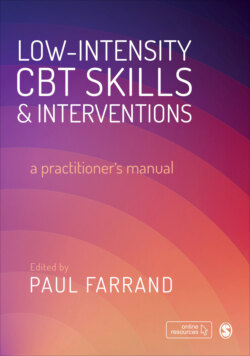Читать книгу Low-intensity CBT Skills and Interventions - Группа авторов - Страница 137
На сайте Литреса книга снята с продажи.
Improving Diagnosis Rates
ОглавлениеDiagnosis is important for determining appropriate, evidence-based treatments in LICBT services, but in 2018–19 across all IAPT services, only 63.5 per cent of service users who had at least one treatment session had received a probable diagnosis, and the range across all services nationally was between 14 and 99 per cent (NHS Digital, 2019). This suggests that for just over a third of IAPT service users across the country and nearly all of the service users in some services, the clinical problem may not have been adequately identified, which may have resulted in inappropriate treatment being delivered (Clark et al., 2018; Gyani et al., 2011).
Table 3.2
The proportion of patients with a recorded probable diagnosis has been found to be associated with the proportion of patients achieving good treatment outcomes – for example, reliable recovery and reliable improvement (Clark et al., 2018). A number of IAPT services have conducted service evaluations to understand the problems associated with a lack of appropriate use of probable diagnosis and clarify ways in which they might improve the use of diagnoses in their services. Such evaluations have shown that most diagnoses are under-identified by LICBTs when comparing rates of probable CMDs to those determined by an established diagnostic screening tool, particularly in relation to PTSD and OCD (Cernis et al., 2016). However, one probable diagnosis may be over-reported by LICBT practitioners. That is MADD, which was determined to be the probable diagnosis none of the time when the Psychiatric Diagnostic Screening Questionnaire (PDSQ) was used (Cernis et al., 2016), however it is quite often used in IAPT services (Table 3.2). To improve the use of probable diagnoses, some Step 2 services have offered training and consultation about diagnoses to their staff. Others have sent staff reminders when no probable diagnosis has been assigned and a patient has had at least two treatment sessions. This has helped increase the use of diagnoses and also increase the use of the PHQ9 and GAD in relation to MADD (Cernis et al., 2016). The services that have taken action have also had increased rates of good therapy outcomes for their patients (Pimm et al., 2016).
